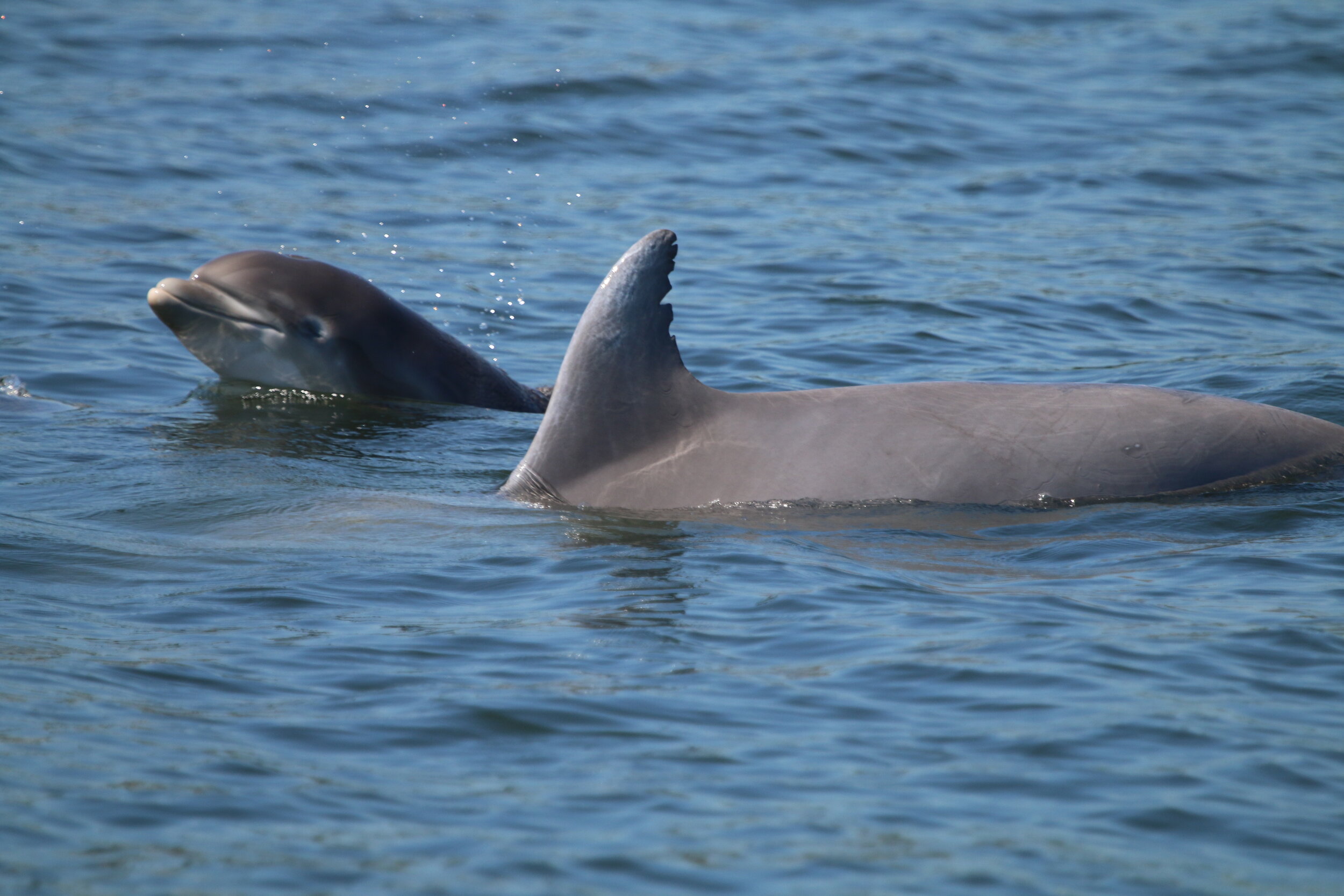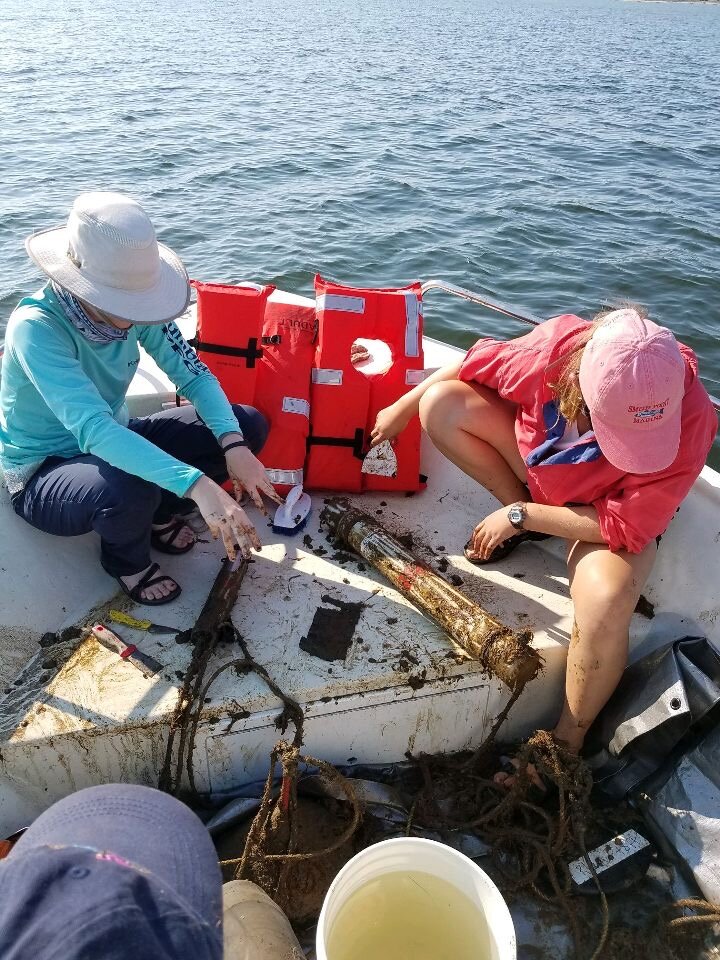Listen to dolphins in the Potomac River! Here’s what they’re telling us…
/How researchers are discovering where dolphins live in our river by listening to their voices
the PCDP Hydrophone team. Image courtesy of Sarah Theissen, Potomac-Chesapeake Dolphin Project.
Guest Author
Ann-Marie Jacoby
Associate Director, Potomac-Chesapeake Dolphin Project
Potomac Conservancy is pleased to bring you another blog in our series on the dolphins of the Potomac River 🐬, from Potomac-Chesapeake Dolphin Project (PCDP) Associate Director Ann-Marie Jacoby.
When the Potomac-Chesapeake Dolphin Project (PCDP) launched in 2015, many people living in the Potomac River region were surprised to hear that dolphins were among their neighbors!
Since then, our team has received many inquiries asking when and where dolphins can be seen along the Potomac, or in other words inquiries about what we scientists call their spatiotemporal distribution.
This past summer, the Potomac-Chesapeake Dolphin Project, a Georgetown University research project directed by Professor Janet Mann, continues to tackle that question with a method new to us - listening for dolphins! Find out how this process works in the Potomac, what we’re learning, and hear from the dolphins yourself.
Why listen for dolphins?
Beyond our data collection at the mouth of the Potomac and occasional reports of sightings upriver from citizen scientists, the truth is we still have a lot to learn about the space use and movement patterns of dolphins throughout the Potomac.
This summer PCDP researchers, including myself and Georgetown University Ph.D. student Ellen Jacobs, are tackling questions such as: Where in the river do dolphins go? What time of year do they use different parts of the river? How often do they visit these different parts of the Potomac? And what are they doing in the Potomac?
IMage Courtesy of Ann-Marie Jacoby, Potomac-Chesapeake Dolphin Project, Taken Under NOAA NMFS Permit No. 19403
The Potomac River is large, which makes searching for dolphins on a boat throughout its tidal region logistically and financially difficult. As a solution, we have turned to the help of underwater acoustic devices that stand alone in the water and listen for and record nearby dolphins, even when we aren’t around to observe them.
Clicks & Whistles: What sounds do dolphins make (and why)?
Acoustic devices are such a useful tool for studying dolphins, because dolphins have evolved sophisticated vocal and auditory systems to navigate, forage, and communicate with one another in their marine environment. (As we know, it is a little more difficult to see and hear in water than on land!)
Audio credit: Woods Hole Oceanographic Institution and The Sarasota Dolphin Research Project
Dolphins can hear and produce a plethora of sounds within a range of 150 kilohertz. One of these sounds includes “clicks,” which are a form of echolocation or sonar that allow dolphins to “see” prey and objects far away through an echo.
Another prominent type of sound are whistles, which allow dolphins to recognize one another through something called a signature whistle. A signature whistle is unique to each dolphin - similar to our names!
Audio credit: Woods Hole Oceanographic Institution and The Sarasota Dolphin Research Project
We can only hear a fraction of what dolphins can at a range of less than 20 kilohertz. However, the technology in the two types of acoustic devices we use, known as C-PODs and SoundTraps, can listen for and detect sounds with frequencies within a dolphin’s range or between 20-160 kilohertz.
Recorded detections within this frequency range can then be processed in specialized software giving us information about dolphin use of the Potomac River.
Testing Devices before deployment! IMage Courtesy of Ellen jacobs, the Potomac-Chesapeake Dolphin ProjeCt.
What have we learned so far?
Between October 2020 and March 2021 we deployed our first acoustic device at the mouth of the Potomac to figure out whether or not dolphins were in the area during the colder months of the year.
We’ve learned that dolphins are similar to snowbirds and seem to leave the river at the end of October, which is corroborated by the petering off of dolphin sightings in October from our boat-based observations.
While this gives us information about their seasonal use, it doesn’t tell us about where in the Potomac they go, when they use different parts of the Potomac, and what they are doing there - that’s why we need to keep listening over the summer!
All rope cutting, knot tying, and buoy inflation was done on land over the course of two weeks. Like the rigs, our acoustic devices were also setup on land. IMage Courtesy of Ellen jacobs, the Potomac-Chesapeake Dolphin ProjeCt.
How to use a small boat to listen to a big river
To get at these questions, we spent our 4th of July deploying an array of 7 acoustic devices from the mouth of the Potomac up to the 301 Highway Bridge near Dahlgren, VA or 70 miles upriver. Each device is equally spread apart at 9 miles and can detect dolphins up to a one-mile radius.
To make sure the acoustic devices were secure in open water, we used a rig design that would withstand time and stormy weather. There is a cost to reliability though, as each rig weighs over 100 lbs and requires multiple buoys. That’s over 700 lbs of gear!
Deployments therefore took quite a bit of logistical planning, muscle, and determination to pull off for a team of 5 and a relatively small 18-foot boat that does not have a winch.
IMage Courtesy of Sarah Theissen, Potomac-Chesapeake Dolphin Project
A special surprise
We got an extra special treat while deploying that made all of hard work worth it. For the first time, we saw dolphins off Colonial Beach, VA… the furthest upriver they have been sighted in recent years!
Dolphins we have been seeing at the mouth of the river since the PCDP started in 2015 make their way 50 miles upriver. How exciting is that?!
We saw dolphins Paul Ryan, Al Gore, Kay Bailey Hutchison, Walter Mondale, Tammy Duckworth, and several more including babies. (Meet more of our frequently-spotted dolphins here!)
IMage Courtesy of Melissa Collier, the Potomac-Chesapeake Dolphin ProjeCt. Taken Under NOAA NMFS Permit No. 23782
Always listening
Even though we can’t always make it up to Colonial Beach with our boat, the acoustic devices are listening for us, and our hard work and efforts continue to pay off.
We checked back in on our devices after one month in the beginning of August, and we are happy to report that the acoustic devices are still there and recording.
But, wow, they were completely covered in marine life, including sea squirts, barnacles, and worms. We clean them before putting them back into the water, but both the research team and the boat came back looking a complete mess!
IMage Courtesy of Sarah Theissen, Potomac-Chesapeake Dolphin Project
Listen to your local dolphins!
During our most recent check-up we were able to extract some data files. Check out what some of the July dolphin acoustic data looks and sounds like so far!
This sound is a group of ~40 dolphins making foraging buzzes and whistles. (There is a hooting noise too which is an oyster toadfish.)
Credit: Potomac-Chesapeake Dolphin Project, Ellen Jacobs
🎧 Tune back in!
We will be extracting data from all seven of our acoustic devices later this fall, so stay tuned on what we learn about where and when dolphins are in the Potomac.
To get frequent updates and learn more about our research, follow us on Facebook and Instagram and check-out our website.
How you can help
If you live along the Potomac River: Have you spotted a dolphin? Let us know by emailing pcdolphinproject@gmail.com!
It’s a huge help to know where dolphins are in real time and to validate any dolphin detections the acoustic devices record.
If you live anywhere: This work is costly and requires a lot of equipment and labor to carry out. If you would like support our project, you can make a donation towards our ongoing research.
About the Expert
Ann-Marie Jacoby is a PhD Candidate in Marine Science and Conservation at the Duke University Marine Lab, as well as the Associate Director of the Potomac-Chesapeake Dolphin Project. Her doctoral research focuses on the historic and present-day occurrence of bottlenose dolphins (Tursiops truncatus) in the Potomac River and middle Chesapeake Bay to improve the conservation of mid-Atlantic bottlenose dolphin populations and the Potomac River-Chesapeake Bay ecosystems they are a part of.























